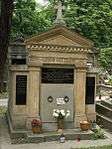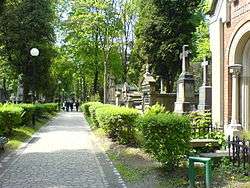Rakowicki Cemetery
|
Alleyway between tombs | |
 | |
| Details | |
|---|---|
| Established | 1803 |
| Location | Rakowiecka 26, Kraków |
| Country | Poland |
| Coordinates | 50°04′30″N 19°57′07″E / 50.075°N 19.952°ECoordinates: 50°04′30″N 19°57′07″E / 50.075°N 19.952°E |
| Type | Public |
| Style | Architectural |
| Owned by | ZCK Krakow |
| Size | 42 hectares (100 acres) |
| Website | Unofficial Site |
| Find a Grave | Rakowicki Cemetery |
Rakowicki Cemetery (Polish: Cmentarz Rakowicki) is a cemetery in Poland, located in the centre of Kraków. It lies within the Administrative District No. 1 Stare Miasto meaning "Old Town" – distinct from with the historic Kraków Old Town further west. Founded at the beginning of the 19th century when the region was part of Austria-Hungary), the cemetery was expanded several times, and at present covers an area of about 42 hectares. Many notable Cracovians, among them the parents of Pope John Paul II, are buried here.[1][2]
History
The Rakowicki Cemetery was set up in 1800–1802 at an estate in Prądnik Czerwony village, originally on an area of only 5.6 ha. It was first used in mid-January 1803. The new cemetery came into existence in relation to a public health-related government ban on burials in old church cemeteries within the city. The land was purchased for 1,150 zloty from the monastery of the Discalced Carmelites of Czerna, and built with funds from the city and the surrounding villages (including some future Districts of Kraków): Rakowice, Prądnik Czerwony and Biały, Olsza, Grzegórzki, Piaski, Bronowice, Czarna Village, Nowa Village, Krowodrza and Kawiory, all granted the right to bury their dead there. The first funeral took place on January 15, 1803, with the burial of an 18-year-old named Apolonia from the Lubowiecki family of Bursikowa estate.[3]
In 1807, the first well was dug, and in 1812 the first big cross was built, paid for by public contributions. Rakowicki Cemetery was repeatedly enlarged over the years. The first expansion came in 1836 when 100% more land was bought from Carmelite friars for 5,000 zloty. The design of the new part of the cemetery was commissioned from architect Karol R. Kremer, head of the department of urban construction, who gave it the form of a city park. The surrounding wall was made using bricks and stones obtained from the demolished Church of All Saints. The newly built cemetery was blessed on November 2, 1840. The first chapel was erected in 1862, six years after the Austrian permit was issued. In 1863 the city purchased more land from Carmelite friars – and from Walery Rzewuski – on the west side of the cemetery, and buried there victims of an epidemic of 1866. In 1877 the new administrative centre was built along with the mortuary. The next expansion took place ten years later, in the autumn of 1886. In this new section the nominal painter Jan Matejko was buried there, among other notables.[4]
Between 1933 and 1934 the cemetery was widened at its north end, across an old military base, with a city street eliminated. In 1976, it was finally entered into the list of local heritage sites, and in 1979 it was the last place visited by Pope John Paul II during his June 2–10 first papal visit to his native homeland.
Cultural significance
The necropolis is a place of burial of the ordinary citizens of the city as well as national heroes: famous writers, scientists, representatives of noble families, independence fighters, political and social activists, leaders and participants of Polish independence movements and insurrections and veterans of the 20th century's two World Wars, among others. The name Rakowicki Cemetery derives from the name of the Rakowicka street, once a suburban road leading to the village of Rakowice 2 km away.
Layout
Within the cemetery, there are special sections allocated to graves of the participants of Polish national uprisings such as the November Uprising, the January Uprising and the Kraków Uprising. First World War casualties are buried there, including ethnically Polish soldiers conscripted into all three imperial armies: Austrian, Russian and Prussian – most of whom died in local hospitals. There are members of Polish Legions; the participants of the Charge at Rokitna; the workers killed during strikes of 1936; Second World War casualties including soldiers of the Polish September campaign of 1939. All Allied pilots shot down over Poland are buried here, including those originally buried in Warsaw, along with hundreds of Commonwealth of Nations casualties and prisoners of war who died during the German occupation; the latter brought together by the BAOR into a Commonwealth plot containing a Cross of Sacrifice.[5][6] Polish partisans, the victims of Nazi crimes; and Soviet soldiers who died during their anti-German attack on Kraków in 1945, are buried here.[7][8]
National significance
The cemetery is a national monument of great historical and artistic value. Its selected gravestones and mausoleums are the work of well-known architects, among them, Teofil Żebrawski, Feliks Księżarski, Sławomir Odrzywolski, Jakub Szczepkowski, as well as sculptors such as Konstanty Laszczka, Tadeusz Błotnicki, Wacław Szymanowski, Karol Hukana and others. In 1981 a Public Committee for the Preservation of Kraków was founded, with a special sub-committee for the saving of the cemeteries of Kraków and other regional heritage sites. OKRK is organizing an annual collections for the restoration of historic tombs and gravestones. Works are being conducted simultaneously at the Rakowicki Cemetery and the New Foothill Cemetery (with the cooperation of the Association Podgórze.pl). OKRK is organizing an annual donation drive, raising funds for the renovation of historic tombs and the public monuments. Public funds are used for the restoration of deteriorating tombs without owners.[9]
Notable individuals
Those buried at the Rakowicki Cemetery include:
Points of interest
-

Funerary statue
-

Funerary statue
-

Lasocki family tomb
-

Dietl family tomb
-

Tomb of Janina Gałowa, statue by Gosławski
-

Graves of Allied pilots shot down over Poland
-

Soviet casualties of the 1945 operation Kraków
-

Monument to Polish victims of Communism
See also
Notes and references
| Wikimedia Commons has media related to Rakowicki Cemetery. |
- ↑ (Polish) Gazeta Krakow.pl, October 29, 2008, ""Zwiedzamy Cmentarz Rakowicki" (Touring the Rakowicki Cemetery at All Saints Day)" (PDF). (328 KB)
- ↑ A multilingual brochure available for the visitors, called "Zwiedzamy Cmentarz Rakowicki" (A visit to the Rakowicki Cemetery) with a map describing a two-hour walk, is published by Zarząd Cmentarzy Komunalnych w Krakowie.
- ↑ (Polish) Karolina Grodziska, "Plan Cmentarza Rakowickiego," Gazeta.pl Krakow, 2002-10-30.
- ↑ Rakowicki Cemetery at cracow-life.com
- ↑ Commonwealth War Graves Commission, Krakow Rakowicki Cemetery
- ↑ Szymon Madej, Kraków Military Cemetery
- ↑ "Poland and the Commonwealth War Graves Commission. "Who we are and what we do."" (PDF). (281 KB)
- ↑ Veterans Affairs Canada, Press-release: Canadian Airmen Laid to Rest During Rededication Ceremony Sep 28, 2007.
- ↑ (Polish) Obywatelski Komitet Ratowania Krakowa
- Internetowy lokalizator grobów Zarządu Cmentarzy Komunalnych w Krakowie
- Galeria zdjęć Cmentarza Rakowickiego
External links
- Online grave locator in Krakow (Polish: Internetowy lokalizator grobów w Krakowie)
- 25439265 Location of the Rakowicki Cemetery on OpenStreetMap
- Cemetery Details. Commonwealth War Graves Commission.

